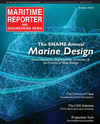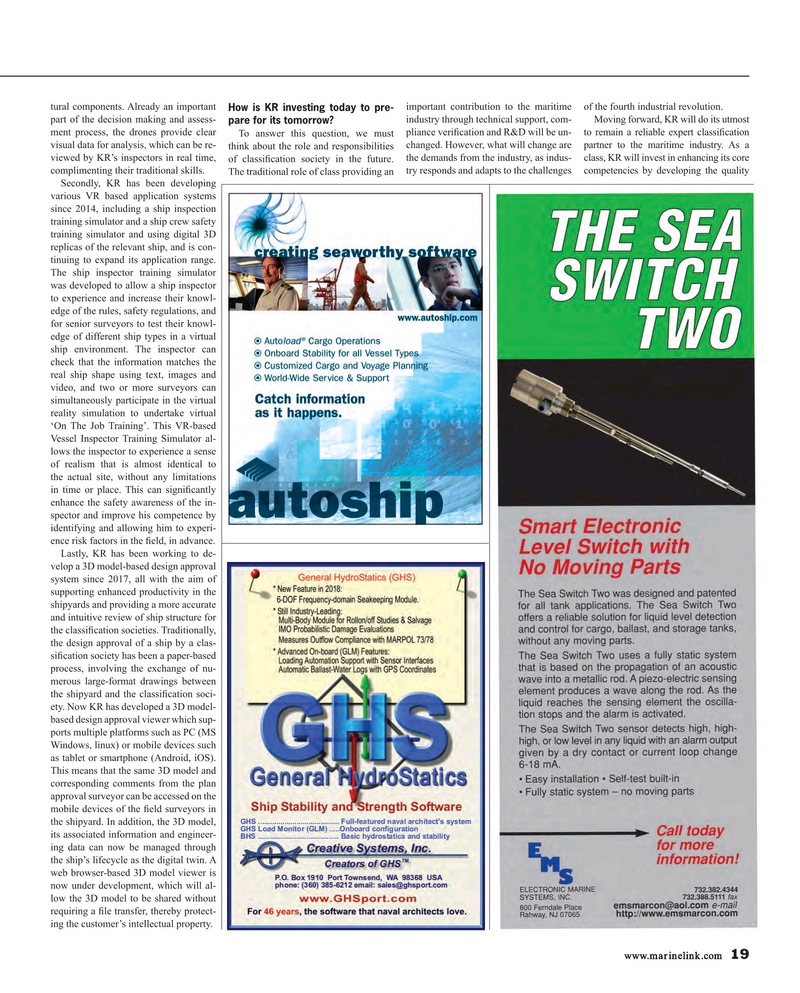
Page 19: of Maritime Reporter Magazine (October 2018)
Marine Design Annual
Read this page in Pdf, Flash or Html5 edition of October 2018 Maritime Reporter Magazine
tural components. Already an important How is KR investing today to pre- important contribution to the maritime of the fourth industrial revolution.
part of the decision making and assess- industry through technical support, com- Moving forward, KR will do its utmost pare for its tomorrow?
ment process, the drones provide clear To answer this question, we must pliance veri? cation and R&D will be un- to remain a reliable expert classi? cation visual data for analysis, which can be re- think about the role and responsibilities changed. However, what will change are partner to the maritime industry. As a viewed by KR’s inspectors in real time, of classi? cation society in the future. the demands from the industry, as indus- class, KR will invest in enhancing its core complimenting their traditional skills. The traditional role of class providing an try responds and adapts to the challenges competencies by developing the quality
Secondly, KR has been developing various VR based application systems since 2014, including a ship inspection training simulator and a ship crew safety training simulator and using digital 3D replicas of the relevant ship, and is con- tinuing to expand its application range.
The ship inspector training simulator was developed to allow a ship inspector to experience and increase their knowl- edge of the rules, safety regulations, and for senior surveyors to test their knowl- edge of different ship types in a virtual ship environment. The inspector can check that the information matches the real ship shape using text, images and video, and two or more surveyors can simultaneously participate in the virtual reality simulation to undertake virtual ‘On The Job Training’. This VR-based
Vessel Inspector Training Simulator al- lows the inspector to experience a sense of realism that is almost identical to the actual site, without any limitations in time or place. This can signi? cantly enhance the safety awareness of the in- spector and improve his competence by identifying and allowing him to experi- ence risk factors in the ? eld, in advance.
Lastly, KR has been working to de- velop a 3D model-based design approval system since 2017, all with the aim of supporting enhanced productivity in the shipyards and providing a more accurate and intuitive review of ship structure for the classi? cation societies. Traditionally, the design approval of a ship by a clas- si? cation society has been a paper-based process, involving the exchange of nu- merous large-format drawings between the shipyard and the classi? cation soci- ety. Now KR has developed a 3D model- based design approval viewer which sup- ports multiple platforms such as PC (MS
Windows, linux) or mobile devices such as tablet or smartphone (Android, iOS).
This means that the same 3D model and corresponding comments from the plan approval surveyor can be accessed on the mobile devices of the ? eld surveyors in the shipyard. In addition, the 3D model, its associated information and engineer- ing data can now be managed through the ship’s lifecycle as the digital twin. A web browser-based 3D model viewer is now under development, which will al- low the 3D model to be shared without requiring a ? le transfer, thereby protect- ing the customer’s intellectual property. www.marinelink.com 19
MR #10 (18-25).indd 19 MR #10 (18-25).indd 19 10/5/2018 2:48:27 PM10/5/2018 2:48:27 PM

 18
18

 20
20
